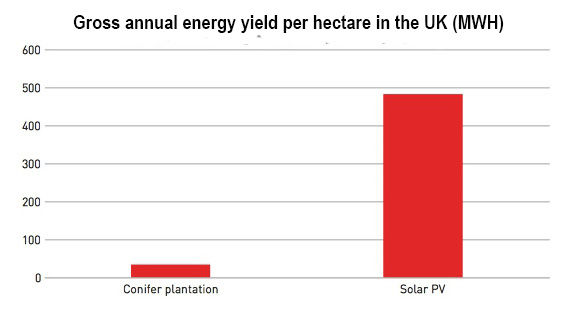How much more land do we need for energy from biomass compared to solar PV?
Right now, all wood burned in UK power stations other than Drax Plc comes from the UK, mostly from conifer plantations. On average, one hectare of a UK conifer plantation will convert sunlight to 33.17 megawatt hours’ (MWh) worth of energy annually1.
On the other hand, one hectare of solar PV in the UK will generate 481.8 MWh of electricity a year (taking account of the fact that the sun does not shine all of the time)2. In reality, solar PV on roofs requires no additional land at all, and solar PV panels on farmland can be, and commonly are, combined with grazing3. Please note that the NFU’s figure for the energy yield for solar PV in the UK is conservative. Significantly higher outputs have been reported from projects in England.

If one looks at the actual amount of electricity generated from biomass versus solar PV from one hectare of land, the figures are even worse for biomass.
With the exception of Drax, biomass-burning power stations in the UK operate at well below 35% efficiency. Even if they were to reach 35%, 65% of the energy contained in the wood will be lost immediately, as uncaptured heat. So, the actual amount of electricity gained from one hectare of land used to produce wood burned in power stations is just 11.61 MWh per year!
Of course, energy is required to produce and mount solar PV panels. Energy is also required to maintain and log conifer plantations, turn the trees into woodchips or pellets, transport them to the power station – and, indeed, to build the power station in the first place. There are many studies looking at net energy gains from different energy technologies. Again, the picture is much worse for biomass than for solar PV. According to a comprehensive analysis carried out by researchers from Oxford and Naples, the energy balance for biomass electricity is by far the worst of all sources of energy – 3-8 times worse than that of solar PV! So the net energy gain from that one hectare of conifer plantation will be so small that would barely show up in a graph!
- According to the Forestry Commission, the mean annual increment (i.e. energy contained in average annual tree growth) of a UK Sitka spruce plantation is 15m3 per hectare (forestry.gov.uk/pdf/FCBK048.pdf/$FILE/FCBK048.pdf , page 22). Sitka spruce is one of the most common species grown in UK tree plantations. According to the UN Economic Commission for Europe (UNECE), the average conversion of cubic metres to oven-dry tonnes (odt) is 2.41 m3 per odt for softwood, such as Sitka spruce. Therefore, the annual mean increment of UK Sitka spruce is 6.22 odt/ha. According to the UN Food and Agriculture Organisation, the typical calorific value of oven-dry softwood is 19.2 MJ/kg (fao.org/3/a-i4441e.pdf). This converts to 5.33 MW/odt. The annual increment for 1 hectare of softwood is thus 33.17 MWh.
- According to the UK’s National Farmers Union, a 1 MW solar PV installation requires 2 hectares (nfuonline.com/assets/21480) , so 1 hectare supports a solar PV capacity of 0.5 MW. If a 0.5 MW installation was to operate at full capacity all year round, it would generate 4,380 MWh. For solar PV, this would require non-stop maximum sunlight, 2 hours a day, which is of course impossible. According to the UK Government, solar PV operated at an average of 11% of its capacity during 20016 (https://www.gov.uk/government/uploads/system/uploads/attachment_data/file/633782/Chapter_6.pdf). Therefore, one hectare of solar PV produces 11% of 4,380 MWh per year , which is 481.8 MWh.
- Agricultural Good Practice Guidance for Solar Farms, BRE National Solar Centre, 2014, bre.co.uk/filelibrary/nsc/Documents%20Library/NSC%20Publications/NSC_-Guid_Agricultural-good-practice-for-SFs_0914.pdf
